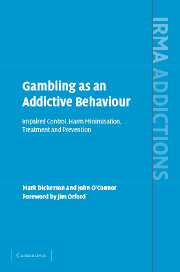Book contents
- Frontmatter
- Contents
- Preface
- Declaration
- Executive Summary
- Glossary
- Foreword
- List of Tables
- List of Figures
- 1 The Research Context
- 2 Research into Impaired Control of Gambling Behaviour, Definition and Measurement: Traditional Psychometric and Mathematical Psychology Approaches
- 3 Impaired Control and its Relationship to other Variables Implicated in the Development of Pathological Gambling
- 4 Models of Impaired Self-Control of Gambling
- 5 Implications for Treatment Approaches to Problem Gambling Arising from the Model of Impaired Control
- 6 Implications for Harm Minimisation in the Management of Problem Gambling: Making Sense of “Responsible Gambling”
- 7 A Case Study of “Responsible Gambling” Strategies within a Single Jurisdiction: Victoria, Australia
- 8 Conclusions
- References
- Index
Foreword
Published online by Cambridge University Press: 07 September 2009
- Frontmatter
- Contents
- Preface
- Declaration
- Executive Summary
- Glossary
- Foreword
- List of Tables
- List of Figures
- 1 The Research Context
- 2 Research into Impaired Control of Gambling Behaviour, Definition and Measurement: Traditional Psychometric and Mathematical Psychology Approaches
- 3 Impaired Control and its Relationship to other Variables Implicated in the Development of Pathological Gambling
- 4 Models of Impaired Self-Control of Gambling
- 5 Implications for Treatment Approaches to Problem Gambling Arising from the Model of Impaired Control
- 6 Implications for Harm Minimisation in the Management of Problem Gambling: Making Sense of “Responsible Gambling”
- 7 A Case Study of “Responsible Gambling” Strategies within a Single Jurisdiction: Victoria, Australia
- 8 Conclusions
- References
- Index
Summary
Like gamblers who experience the mixed emotions of excitement, hope, regret and depression, reading the foregoing chapters has left me with mixed feelings of stimulation, dismay and reassurance. Let me try to unpick the tangle, starting with stimulation.
Stimulation
I am greatly stimulated by Dickerson and O'Connor's central idea of a continuum of control and choice over gambling (they acknowledge their debt to Heather et al.'s idea of impaired control over the consumption of alcohol). In place of diagnosing pathology, they draw on a variety of studies that they and their colleagues have carried out, including a qualitative study of limit setting amongst 16–24-year-old regular gamblers, which support the continuum of control concept. The dimension runs from “free effortless enjoyment”, via the exertion of increasing effort to resist, to a position in which self-control can scarcely be maintained. The 12-item Scale of Gambling Choices that their group has developed for assessing control over gambling correlates highly with scores on the most commonly used measure of problem gambling – The South Oaks Gambling Screen – and with measures of greater gambling involvement, more time and money spent gambling, and the accumulation of higher debts.
That way of understanding the essence of problematic gambling represents an important shift that is bound to be controversial. It recognises the reality of difficult-to-control gambling whilst rejecting the idea of a diagnosable entity called “pathological gambling” or “compulsive gambling”.
- Type
- Chapter
- Information
- Gambling as an Addictive BehaviourImpaired Control, Harm Minimisation, Treatment and Prevention, pp. xvii - xxivPublisher: Cambridge University PressPrint publication year: 2006

